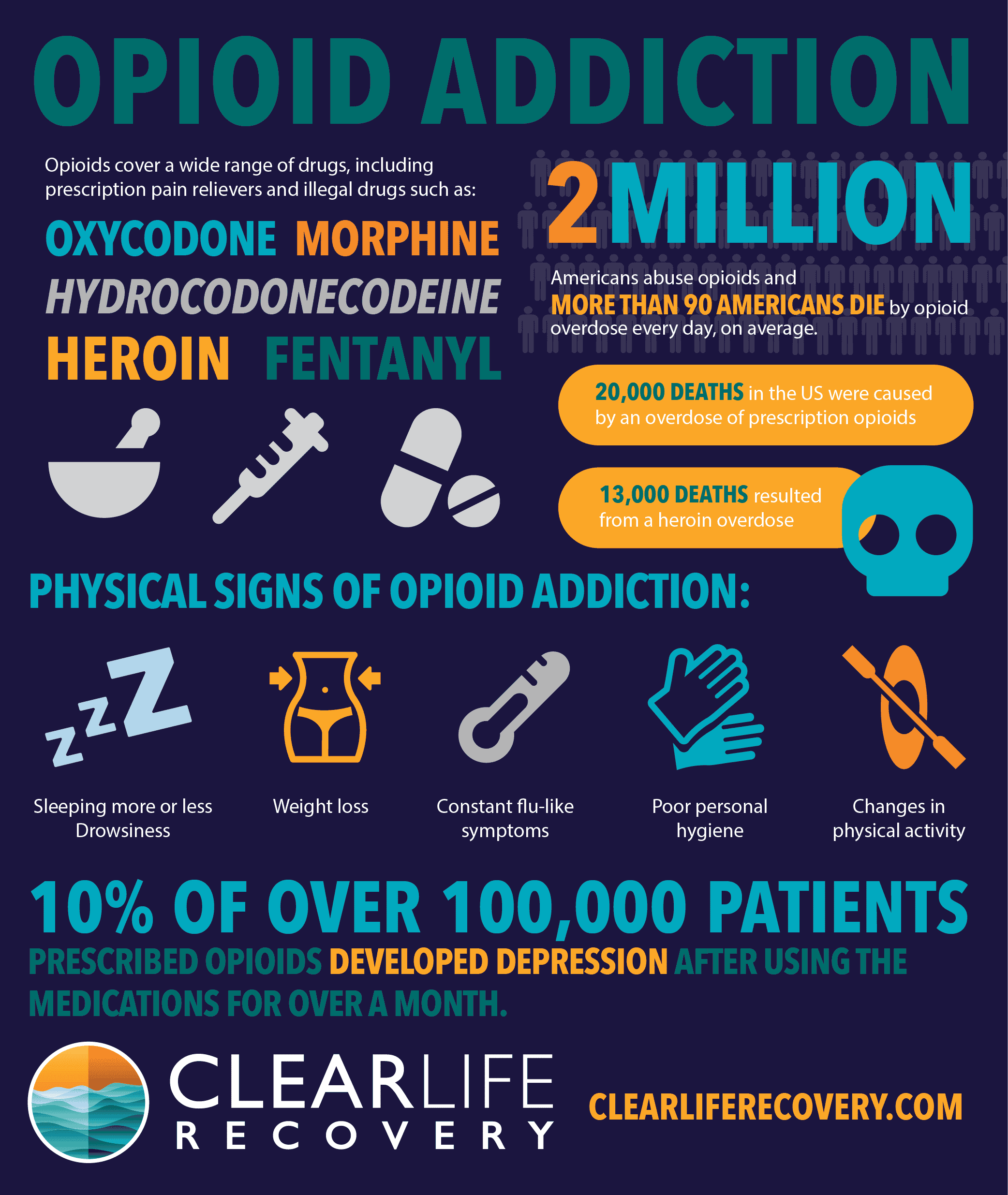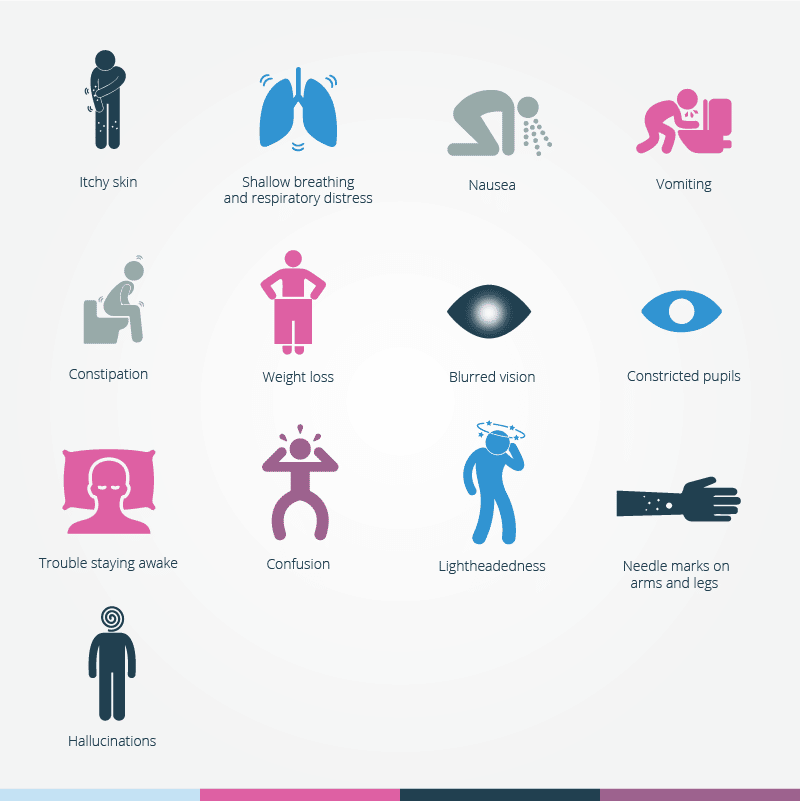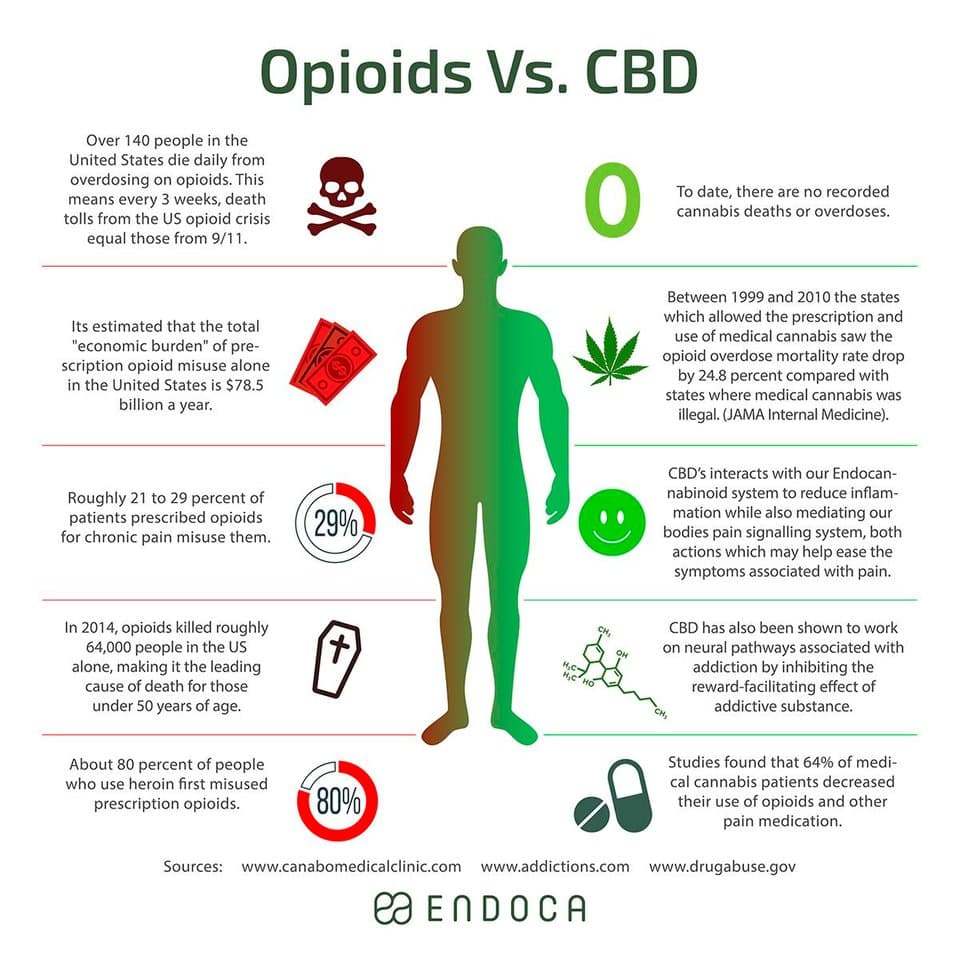Symptoms Of Opioid Addiction
Symptoms of opioid addiction can be the keys to getting help for yourself or your loved one. Opioid addiction can be fatal when left unchecked. Unfortunately, opioid addiction can be tricky to spot, so knowing what to watch for is important. While technically theres a difference between symptoms and signssimply put, symptoms are felt while signs are seenhere theyre combined as opiate addiction symptoms and signs.
First and foremost, symptoms of opioid addiction begin with misuse or abuse. Both misuse and abuse involve the same behavior: using a drug for pain relief and the high that comes from taking it. Once someone develops opioid dependence and tolerance, he needs more and more of the drug, and he needs to keep it in his system consistently to avoid unpleasant opioids withdrawal symptoms. This is when the misuse or abuse begins, and the person uses too much, taking more prescription pain pills than prescribed or buying an increasing amount of an illicit street drug like heroin.
The difference between misuse and abuse is the intent. In misuse, the person is using prescription painkillers incorrectly, taking higher doses than prescribed and doing it more frequently than she was instructed by her doctor. She does this because she is craving the pain relief she needs as well as the high that comes with it. In abuse, someone purposely seeks either pain pills that arent prescribed to her or heroin specifically to get high.
Environmental Signs Of Opioid Abuse
If you suspect a loved one is abusing opiates, pay careful attention to their living space. There may be drug paraphernalia that indicates drug use is happening there.
Paraphernalia will differ depending on the type of opioid theyre using. Pills generally leave little evidence unless theyre crushed. Heroin, which is usually injected, involves more paraphernalia.
Keep an eye out for:
- Prescription bottles with the labels ripped off
- Needles or syringes
What You Need To Know
- Opioid addiction is a serious medical condition.
- Though the cause of OUD is not known, people may take opioids in an unhealthy way to achieve euphoria or to prevent withdrawal symptoms.
- Signs and symptoms of opioid use disorder include craving, risky use and withdrawal symptoms if the opioid is discontinued. If not treated, opioid use disorder can lead to overdose and death.
- Treatment, including drugs that can ease craving and help people discontinue opioid use, can help manage opioid use disorder.
Don’t Miss: Addiction Institute At Mount Sinai
What Are Opioid Withdrawal Symptoms And How Can You Alleviate Them
Opioid withdrawal symptoms can but wonât necessarily include some of the following:
Opioid withdrawal symptoms generally last between three and five days, although they can last up to 10 days, according to the American Society of Addiction Medicine .
Withdrawal from opioids can be difficult and even dangerous. Trying to quit âcold turkeyâ is not recommended, ASAM advises, because it can lead to stronger cravings and continued use. The safest way to alleviate opioid withdrawal symptoms is through medically supervised treatment that generally includes medicines, counseling, and support. Some medications used to relieve withdrawal symptoms are methadone and buprenorphine . These medications can also be used as long-term maintenance medicine for opioid dependence. In addition, a medication called clonidine can be used during withdrawal to help reduce anxiety, agitation, muscle aches, sweating, runny nose, and cramping. It does not help reduce cravings. The addiction medicine physician may also prescribe medication to treat vomiting and diarrhea and help with insomnia.
Physical Signs And Symptoms Of Opioid Addiction

For some individuals, their first use of a strong opioid will addict them. For others, they may use an opioid occasionally over a period of years, eventually becoming addicted or deciding to leave the drugs alone.
It is possible to detect a person who is addicted to opioids by looking for these signs and symptoms.
- Reduced ability to think clearly
- Unsteadiness and difficulty walking
When a person injects opioids, they increase their risk of contracting HIV, Hepatitis C or serious infections of their skin and soft tissue or the lining of the heart.5
Of course, a fatal overdose is possible every time opioids are used. Spontaneous abortion is another side effect of opioid addiction.
Also Check: Does Medicare Pay For Alcohol Addiction Treatment
Signs And Symptoms Of Addiction To Opioids: Other Behaviors
In addition to the drug-seeking behaviors that are a hallmark of addiction, someone addicted to opioids exhibits other telling behaviors as well, such as:
- Secrecy about use of opioids
- Increased isolation to hide drug use
- Social isolation
- Wearing clothing that hides track marks
- Poor work performance
- Letting relationships slide
- Changing friends, sudden association with a different crowd
- Neglect of personal hygiene
- No longer caring about appearance
Cardinal Health Takes Stance Against Their Part In The Opioid Addiction Epidemic
The opioid addiction crisis has ravaged communities across America. But who is to blame? The opioid addiction epidemic has many players, including the pharmaceutical companies that manufacture opioid medications. The National Institute on Drug Abuse estimates that the percentage of opioid addiction that began with a legitimate prescription is around 6%. The availability of these drugs remains an issue.
Cardinal Health denies blame for their role in manufacturing and distributing opioids. Writing to The Columbus Dispatch, spokeswoman Brandi Martin explains that they have reported all of their sales and pharmacies that received opioids. They do say that they have not previously had access to all of the data about opioids pharmacies received from other distributors. Martin further explained that they do not have any legal authority to oversee dispensing or prescribing practices.
Don’t Miss: Can You Get Addicted To Anything
What Are The Signs Of Opioid Addiction And Abuse
There are various signs and symptoms of opioid abuse and addiction. Someone who abuses opioids may feel excessively drowsy and have slowed heart rate. They may feel tired, depressed, or weak, even if they have just woken up from sleeping for several hours.
Respiratory depression also occurs when a person abuses opioids. Shortness of breath or trouble breathing could be another sign of addiction and other health problems. If you think that your loved one may have an addiction to opioids, its important to see a doctor to check for respiratory issues as soon as possible.
These drugs cause the eyes pupil-constricting muscles to contract more strongly than usual, leading to constricted pupils when a person is using them. Nausea and vomiting are also symptoms of opioid use disorder . Theyre often side effects of taking high doses over time however, nausea and vomiting can also occur after just one dose, depending on how much was taken.
Development Of Other Health Issues
âProlonged codeine abuse may contribute to lung infections, sleep disorders, irregular heart rate, and in some cases, brain damage.â Sean Ormond, MD at Atlas Pain Specialists, tells WebMD Connect to Care.
âWhile any one of these symptoms can indicate an unhealthy relationship with codeine, a combination of these symptoms is even more telling.â continues Parmar. âIf you have increased your dosage of codeine over time without a valid medical reason to do so, you may be developing a codeine addiction. If you regularly âforgetâ to eat meals or eat very small portions, you could be experiencing codeine effects. And if you regularly use other drugs like alcohol or marijuana to âboostâ your codeine experience, it could be a sign of a larger problem. These are signs that you have a potential codeine addiction.â
Also Check: Is Alcohol The Most Addictive Drug
Why Seniors Are At Risk
It could be due in part to how often doctors prescribe opioids to senior citizens.
From 1996 to 2010, there was a significant increase in the number of opioid prescriptions given to older people, according to a 2018 article in the Psychiatric Times entitled âOpioid Use in the Elderly.â The report also says that 35% of people over 50 years old who had ongoing pain said theyâd misused their prescription opioids in the past month. Misusing certain prescription drugsâwhich means not following your doctorâs instructions on how to safely take themâcan raise your risk for addiction, according to a 2020 article from MedlinePlus entitled âPrescription Drug Misuse.â
A 2020 study in the CDCâs Morbidity and Mortality Weekly Report found that between 2008 and 2018, opioid prescription fill rates were highest among people 65 and older. Whatâs more, a 2018 report from the federal Agency for Healthcare Research and Quality found that on average, almost 4 million senior citizens filled four or more opioid prescriptions in 2015 and 2016. Close to 10 million filled at least one during that timespan.
You Believe Your Loved One Is Addicted To Opioids What Now
As discussed above, opioids cause such profound changes to the brains pleasure and reward functions that an addicted person has difficulty accessing pleasurable feelings or dulling pain without the drug. Its challenging for someone addicted to opioids to recognize they need help or to even acknowledge they have a problem. Professional guidance is crucial in helping your loved one overcome addiction.
What can you do to help?
- Educate yourself about addiction. The more you understand why its so hard for your loved one to stop behavior with such negative consequences, the more you will be able to offer constructive help. The Yale Medicine fact sheet is an excellent place to begin.16
- Attend a support group for those with an addicted loved one. You will receive valuable education, tips, and support from others walking your same path. Support groups like Nar-Anon are spiritually based, while others like LifeRing or Smart Recovery are secular.17
- Gather information on support groups for your loved one and rehabilitation treatment options, including medical detoxification.
- Prepare for and then start the conversation about their drug use. The Substance Abuse and Mental Health Services Administration provides helpful tips for this critical discussion.18
- Consider an intervention to encourage your loved one to agree to treatment.19
Above all, dont be afraid to act if you think your loved one is addicted to opioids. You may save their life.
Recommended Reading: How Long Does It Take To Get Addicted To Opiods
Signs Of Methamphetamine Use
Anyone with a methamphetamine substance use disorder is at a high risk of overdose. By recognizing the side effects and signs of meth use, you may be able to intervene and prevent a meth overdose from occurring.
Meth increases the release of dopamine and, thus, enhances the persons mood and energy levels leading to increased wakefulness and physical activity. The effects of meth on the body with short-term use include an increase in heart rate and blood pressure and a high body temperature .
Other short-term meth use side effects include:
-
Suicidal thoughts
In addition to worsening short-term effects, long-term use of methamphetamine significantly affects a persons behavioral health and physical appearance. Long-term signs of meth use include:
Effects Of Withdrawal And Overdose

The effects of opiate withdrawal can be uncomfortable but are not normally life-threatening. However, withdrawal should always take place in a supervised medical atmosphere. After a person stops using opiates, the symptoms that they experience can last for anywhere between a week to one month. Various withdrawal symptoms that a person may suffer from after ending their opioid use can include:
- Runny nose and teary eyes
- Nausea, vomiting, and diarrhea
- Central nervous system arousal
Although withdrawal from opiates is not typically life-threatening, overdosing on the drug can be fatal. It has been estimated that approximately 17,000 people die as a result of opioid overdose in the U.S. every year. The effects of an overdose can include symptoms similar to those of withdrawal, but can also include:
Co-Occurring Disorders
Also Check: What To Do With An Addict Son
Common Symptoms Of Opioid Withdrawal
The severity of opiate withdrawal symptoms varies widely depending on the drug and duration of use. However, there is a typical timeline for the onset and progression of the signs and symptoms.
In the first few hours after stopping drug use, you may experience the following symptoms:
- Goosebumps on skin.
The severity of the symptoms improves gradually in 72 hours and reduces significantly within a week. But remember that different drugs stay in your system for varying timelines.
Treatment For Narcotic Addiction
Detoxification is often the first step in a treatment plan before addressing a persons addiction to opioids.10 During detox, your doctor or clinician may prescribe medications to help reduce the severity of your withdrawal symptoms and manage the potentially dangerous physiological effects of stopping narcotics use.11
Medication-assisted treatment works by providing a substitute for the narcotic you are addicted to, so your body and brain can gradually adjust to the absence of the substance.12 Medications can prevent or reduce the severity of withdrawal symptoms. Eventually, you will taper off these medications after your body readjusts and the narcotic is out of your system.10
Detoxification methods vary based on the narcotic and other factors. For example, if you misuse heroin, your care team may prescribe the synthetic opiate methadone, which is a longer-acting drug that can be taken orally or injected.13 The dose frequency is gradually reduced to about once a week. Clonidine, another detox medication, lowers blood pressure and is sometimes used to shorten the withdrawal time and relieve physical symptoms for people who are detoxing from heroin.13
You May Like: How To Know If Addicted To Alcohol
How Opioids Affect The Brain
There are opioid receptors in the brain. But they do not produce enough opioids to stop severe pain. So, when an individual takes a pill of Opioid, their brain is filled with Dopamine.Dopamine is often considered the brains feel-good chemical. It rewards natural behavior like eating, exercising, and sex. Repeated use of opioids sends a strong message to the brain to continue using the substance thereby making you addicted to opioids.
What Causes Opioid Dependence And Addiction
Opioid dependence occurs when a persons body adapts to the presence of the drug and begins to depend on it. Dependence is different from addiction, but they often go hand in hand. People with an addiction to opioids cannot control their compulsions and cravings for the drug. This can be caused by social, environmental, psychological, and genetic factors. People prone to addiction because of their genetics may be more likely to develop an opioid dependence after taking prescription pain medication or using heroin or fentanyl recreationally.
They may also have difficulty stopping using these opioids even if they arent in physical pain. Some people may start taking opioids as prescribed but soon begin abusing them, leading to dependence and tolerance. Others may try opioids recreationally and develop compulsive behaviors surrounding the use of these drugs.
You May Like: Can You Get Addicted To Oxycodone
Signs Of Codeine Addiction You Probably Didn’t Know
Codeine is a prescription opiate medication used to relieve mild to moderate pain. It can be found in some prescription cough syrups and tablets and is prescribed by doctors to ease symptoms such as pain and cough. Codeine can also cause a feeling of euphoria and relaxation–a reaction that has the potential to lead to misuse. Learn more about seven key signs of codeine addiction to look out for if youâre concerned by your own or a loved oneâs codeine use.
Learn More About Opioid Addiction
Opiates or opioids, are a group of narcotics that are a derivative of opium and produce a sedative effect when taken. These substances work by depressing the central nervous system and are commonly used to reduce pain or to aid in helping people fall asleep. While some opiates are prescribed by doctors to help treat legitimate pain-related ailments, their effects can lead some people to become addicted. Opiates create a sense of euphoria and well-being, which can be extremely appealing to many individuals. The more often an individual uses opiates, the higher his or her tolerance becomes, causing him or her to need to take higher doses in order to feel the high that was initially obtained. While addiction to opiates is a serious matter, with the right treatment and support individuals can overcome their addiction and go on to lead successful lives.
Statistics
Read Also: Steps Of Recovery From Addiction
How Should You Respond To An Opioid Overdose
If you think someone may be experiencing an opioid overdose, take the following actions immediately:
If You Get Little or No Response
If lightly tapping, shaking, and shouting at the person or rubbing your knuckles on the personâs breastbone do not elicit a response , take the following actions:
How Do Opioids Affect The Brain

Opioids activate opioid receptors in brain nerve cells to block pain signals and increase feelings of well-being. Opioids affect the reward center of the brain, triggering the brain to release unnaturally high levels of chemicals like dopamine, which flood the brain with a sense of euphoria. The feeling of pleasure is so intense that the user is motivated to continue drug-seeking behavior.8
As opioid use continues, the brain demands higher or more frequent doses of the drug to deliver the desired effect. This demand for more significant amounts is called tolerance and often leads to dependence, a physical and psychological need for the drug. Once a person depends on an addictive substance and stops taking it, they will experience withdrawal symptoms.9 Drug dependence often leads to addiction, defined by the American Society of Addiction Medicine as a treatable, chronic medical disease involving complex interactions among brain circuits, genetics, the environment, and an individuals life experiences.10
The clinical name for opioid addiction is opioid use disorder . The latest edition of the Diagnostic and Statistical Manual of Mental Disorders, 5th edition , provides a checklist of criteria to assist physicians in diagnosing OUD.11
You May Like: Addiction Recovery Games For Groups
